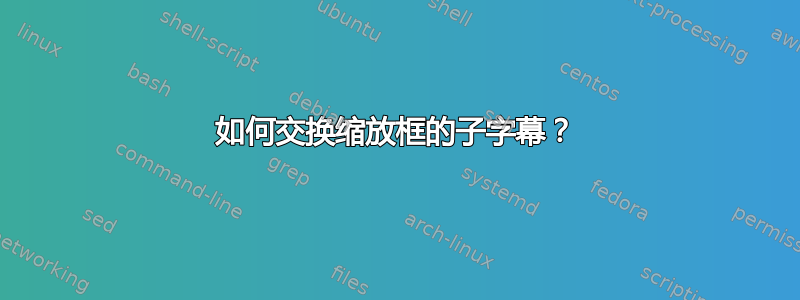
我非常感谢这个问题中给出的缩放框:如何为大图像的各部分创建放大的子图和相应的框。由于评论线程已经足够长,我决定提出一个新问题。
考虑一下我想把盒子放在左边:
\documentclass{article}
\usepackage{tikz,pgfplots,subcaption}
\usetikzlibrary{spy,calc}
%%%%%%%%%%%%%%%%%%%%%%%%%%%%%%%%%%%%%%%%%%%%%%%%%%%%%%%%%%%%%%%%%%%%%%%%%%%%%%%%%%
%%% ZOOMBOX-CODE from https://tex.stackexchange.com/questions/25414 %%%%%%%%%%%%%%%
%%%%%%%%%%%%%%%%%%%%%%%%%%%%%%%%%%%%%%%%%%%%%%%%%%%%%%%%%%%%%%%%%%%%%%%%%%%%%%%%%%
\newif\ifblackandwhitecycle
\gdef\patternnumber{0}
\pgfkeys{/tikz/.cd,
zoombox paths/.style={
draw=orange,
very thick
},
black and white/.is choice,
black and white/.default=static,
black and white/static/.style={
draw=white,
zoombox paths/.append style={
draw=white,
postaction={
draw=black,
loosely dashed
}
}
},
black and white/static/.code={
\gdef\patternnumber{1}
},
black and white/cycle/.code={
\blackandwhitecycletrue
\gdef\patternnumber{1}
},
black and white pattern/.is choice,
black and white pattern/0/.style={},
black and white pattern/1/.style={
draw=white,
postaction={
draw=black,
dash pattern=on 2pt off 2pt
}
},
black and white pattern/2/.style={
draw=white,
postaction={
draw=black,
dash pattern=on 4pt off 4pt
}
},
black and white pattern/3/.style={
draw=white,
postaction={
draw=black,
dash pattern=on 4pt off 4pt on 1pt off 4pt
}
},
black and white pattern/4/.style={
draw=white,
postaction={
draw=black,
dash pattern=on 4pt off 2pt on 2 pt off 2pt on 2 pt off 2pt
}
},
zoomboxarray inner gap/.initial=5pt,
zoomboxarray columns/.initial=2,
zoomboxarray rows/.initial=2,
subfigurename/.initial={},
figurename/.initial={zoombox},
zoomboxarray/.style={
execute at begin picture={
\begin{scope}[
spy using outlines={%
zoombox paths,
width=\imagewidth / \pgfkeysvalueof{/tikz/zoomboxarray columns} - (\pgfkeysvalueof{/tikz/zoomboxarray columns} - 1) / \pgfkeysvalueof{/tikz/zoomboxarray columns} * \pgfkeysvalueof{/tikz/zoomboxarray inner gap} -\pgflinewidth,
height=\imageheight / \pgfkeysvalueof{/tikz/zoomboxarray rows} - (\pgfkeysvalueof{/tikz/zoomboxarray rows} - 1) / \pgfkeysvalueof{/tikz/zoomboxarray rows} * \pgfkeysvalueof{/tikz/zoomboxarray inner gap}-\pgflinewidth,
magnification=3,
every spy on node/.style={
zoombox paths
},
every spy in node/.style={
zoombox paths
}
}
]
},
execute at end picture={
\end{scope}
\node at (image.north) [anchor=north,inner sep=0pt] {\subcaptionbox{\label{\pgfkeysvalueof{/tikz/figurename}-image}}{\phantomimage}};
\node at (zoomboxes container.north) [anchor=north,inner sep=0pt] {\subcaptionbox{\label{\pgfkeysvalueof{/tikz/figurename}-zoom}}{\phantomimage}};
\gdef\patternnumber{0}
},
spymargin/.initial=0.5em,
zoomboxes xshift/.initial=1,
zoomboxes right/.code=\pgfkeys{/tikz/zoomboxes xshift=1},
zoomboxes left/.code=\pgfkeys{/tikz/zoomboxes xshift=-1},
zoomboxes yshift/.initial=0,
zoomboxes above/.code={
\pgfkeys{/tikz/zoomboxes yshift=1},
\pgfkeys{/tikz/zoomboxes xshift=0}
},
zoomboxes below/.code={
\pgfkeys{/tikz/zoomboxes yshift=-1},
\pgfkeys{/tikz/zoomboxes xshift=0}
},
caption margin/.initial=4ex,
},
adjust caption spacing/.code={},
image container/.style={
inner sep=0pt,
at=(image.north),
anchor=north,
adjust caption spacing
},
zoomboxes container/.style={
inner sep=0pt,
at=(image.north),
anchor=north,
name=zoomboxes container,
xshift=\pgfkeysvalueof{/tikz/zoomboxes xshift}*(\imagewidth+\pgfkeysvalueof{/tikz/spymargin}),
yshift=\pgfkeysvalueof{/tikz/zoomboxes yshift}*(\imageheight+\pgfkeysvalueof{/tikz/spymargin}+\pgfkeysvalueof{/tikz/caption margin}),
adjust caption spacing
},
calculate dimensions/.code={
\pgfpointdiff{\pgfpointanchor{image}{south west} }{\pgfpointanchor{image}{north east} }
\pgfgetlastxy{\imagewidth}{\imageheight}
\global\let\imagewidth=\imagewidth
\global\let\imageheight=\imageheight
\gdef\columncount{1}
\gdef\rowcount{1}
\gdef\zoomboxcount{1}
},
image node/.style={
inner sep=0pt,
name=image,
anchor=south west,
append after command={
[calculate dimensions]
node [image container,subfigurename=\pgfkeysvalueof{/tikz/figurename}-image] {\phantomimage}
node [zoomboxes container,subfigurename=\pgfkeysvalueof{/tikz/figurename}-zoom] {\phantomimage}
}
},
color code/.style={
zoombox paths/.append style={draw=#1}
},
connect zoomboxes/.style={
spy connection path={\draw[draw=none,zoombox paths] (tikzspyonnode) -- (tikzspyinnode);}
},
help grid code/.code={
\begin{scope}[
x={(image.south east)},
y={(image.north west)},
font=\footnotesize,
help lines,
overlay
]
\foreach \x in {0,1,...,9} {
\draw(\x/10,0) -- (\x/10,1);
\node [anchor=north] at (\x/10,0) {0.\x};
}
\foreach \y in {0,1,...,9} {
\draw(0,\y/10) -- (1,\y/10); \node [anchor=east] at (0,\y/10) {0.\y};
}
\end{scope}
},
help grid/.style={
append after command={
[help grid code]
}
},
}
\newcommand\phantomimage{%
\phantom{%
\rule{\imagewidth}{\imageheight}%
}%
}
\newcommand\zoombox[2][]{
\begin{scope}[zoombox paths]
\pgfmathsetmacro\xpos{
(\columncount-1)*(\imagewidth / \pgfkeysvalueof{/tikz/zoomboxarray columns} + \pgfkeysvalueof{/tikz/zoomboxarray inner gap} / \pgfkeysvalueof{/tikz/zoomboxarray columns} ) + \pgflinewidth
}
\pgfmathsetmacro\ypos{
(\rowcount-1)*( \imageheight / \pgfkeysvalueof{/tikz/zoomboxarray rows} + \pgfkeysvalueof{/tikz/zoomboxarray inner gap} / \pgfkeysvalueof{/tikz/zoomboxarray rows} ) + 0.5*\pgflinewidth
}
\edef\dospy{\noexpand\spy [
#1,
zoombox paths/.append style={
black and white pattern=\patternnumber
},
every spy on node/.append style={#1},
x=\imagewidth,
y=\imageheight
] on (#2) in node [anchor=north west] at ($(zoomboxes container.north west)+(\xpos pt,-\ypos pt)$);}
\dospy
\pgfmathtruncatemacro\pgfmathresult{ifthenelse(\columncount==\pgfkeysvalueof{/tikz/zoomboxarray columns},\rowcount+1,\rowcount)}
\global\let\rowcount=\pgfmathresult
\pgfmathtruncatemacro\pgfmathresult{ifthenelse(\columncount==\pgfkeysvalueof{/tikz/zoomboxarray columns},1,\columncount+1)}
\global\let\columncount=\pgfmathresult
\ifblackandwhitecycle
\pgfmathtruncatemacro{\newpatternnumber}{\patternnumber+1}
\global\edef\patternnumber{\newpatternnumber}
\fi
\end{scope}
}
%%%%%%%%%%%%%%%%%%%%%%%%%%%%%%%%%%%%%%%%%%%%%%%%%%%%%%%%%%%%%%%%%%%%%%%%%%%%%%%%%%
%%% END ZOOMBOX-CODE %%%%%%%%%%%%%%%%%%%%%%%%%%%%%%%%%%%%%%%%%%%%%%%%%%%%%%%%%%%%%
%%%%%%%%%%%%%%%%%%%%%%%%%%%%%%%%%%%%%%%%%%%%%%%%%%%%%%%%%%%%%%%%%%%%%%%%%%%%%%%%%%
\begin{document}
\begin{figure}
\begin{tikzpicture}[figurename=fig:schmahmann,zoomboxarray,zoomboxes left,zoomboxarray columns=1,zoomboxarray rows=2,connect zoomboxes,zoombox paths/.append style={ultra thick, blue}]
\node [image node] {\includegraphics[width=0.49\textwidth]{example-image-a}};
\zoombox[magnification=3]{0.35,0.48}
\zoombox[magnification=3]{0.66,0.24}
\end{tikzpicture}
\end{figure}
\end{document}
其结果为:

我知道第 90 行和第 91 行需要交换:
\node at (image.north) [anchor=north,inner sep=0pt] {\subcaptionbox{\label{\pgfkeysvalueof{/tikz/figurename}-image}}{\phantomimage}};
\node at (zoomboxes container.north) [anchor=north,inner sep=0pt] {\subcaptionbox{\label{\pgfkeysvalueof{/tikz/figurename}-zoom}}{\phantomimage}};
如果将数字放在左侧。
答案1
好的,我通过以下方式破解了它:
\usepackage{xifthen}% 我无法使用代码中已经使用的 ifthenelse 宏来执行此操作将第 90 行和第 91 行替换为以下代码
\ifthenelse{1=\pgfkeysvalueof{/tikz/zoomboxes xshift}} { \node at (image.north) [anchor=north,inner sep=0pt] {\subcaptionbox{\label{\pgfkeysvalueof{/tikz/figurename}-image}}{\phantomimage}};% \node at (zoomboxes container.north) [anchor=north,inner sep=0pt] {\subcaptionbox{\label{\pgfkeysvalueof{/tikz/figurename}-zoom}}{\phantomimage}}; } { \node at (zoomboxes container.north) [anchor=north,inner sep=0pt] {\subcaptionbox{\label{\pgfkeysvalueof{/tikz/figurename}-zoom}}{\phantomimage}};% \node at (image.north) [anchor=north,inner sep=0pt] {\subcaptionbox{\label{\pgfkeysvalueof{/tikz/figurename}-image}}{\phantomimage}}; }



